 Facebook
Facebook
 X
X
 Instagram
Instagram
 TikTok
TikTok
 Youtube
Youtube

My first eyeballing of Munster, Go Home! came, as it did to many Mockingbird Heights mavens of a certain vintage, on the bottom half of a double-bill. The film had not performed as well as expected, so a worried Universal Studios immediately reissued it in most parts of the country alongside the Don Knotts dud, The Ghost and Mr. Chicken, as part of a TV-theme combo.
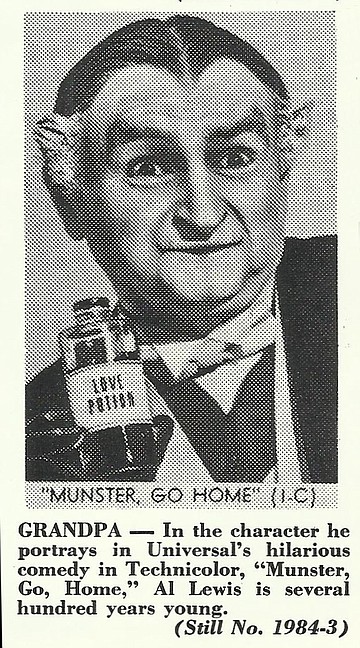
Chicagoans, wishing they had something half as diverting as Mr. Chicken to justify their time spent waiting for Herman and the gang to appear, were asked to endure the long-forgotten family film, ...And Now Miguel, as an appetizer. Little Scooter, in Houston visiting Aunt Tubby (don’t ask!) and Uncle Jerry the week Munster, Go Home! premiered, returned home just in time for Grandpa Bill Marks to escort my cousins and me to the Olympic Theatre in Cicero, IL, where it played alongside the initiatory animal-rights drama, Born Free.
Other than seeing the gang in color for the first time, the strongest memory of my maiden viewing came on the bus ride home when out of the blue Pa, taken by the other film’s catchy theme, started warbling, “Born free, my father’s a doctor.” Pa was a frequent source of embarrassment, but we all loved him dearly.
This was not the first time “TV’s first family of fright” was committed to color stock. (Neither Universal nor CBS would pay the extra $10,000 per episode needed for color, so the show was subsequently filmed in black and white.) In 1964, Universal presented CBS with a 16-minute color demo reel in response to what they saw as the nation’s growing monster mania. A decade earlier the studio had sold its film library to television, and their classic creatures from the 1930s saw a resurgence in popularity. Suddenly monsters became fun and television smelled potential sitcom material. Ray Walston’s “Uncle Martin” was the first out-of-this-world jester to hit the airwaves, and My Favorite Martian became a surprise hit of the 1963 season.
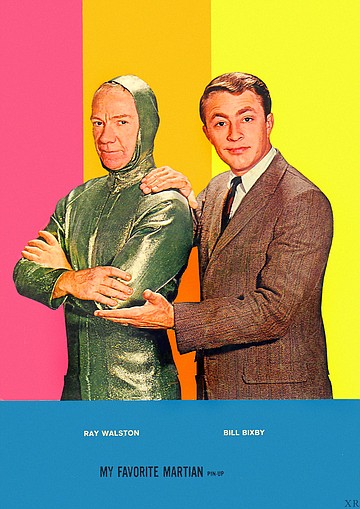
You’ve heard the old saw about there never being enough quality roles for women in television? It couldn’t have been further from the truth in 1964 with a fall roster that saw no less than four supernatural sitcoms, all featuring juicy female leads. There was bewitching Elizabeth Montgomery as Samantha in Bewitched, Julie Newmar as a sexy robot cast opposite a hopelessly sexist Bob Cummings in My Living Doll, and a pair of ghoulish homemakers, Carolyn Jones in The Addams Family and Yvonne De Carlo in The Munsters.
The presentation of The Munsters that Universal put together for the CBS brass was shot on existing sets and used discarded music from a Doris Day picture as its theme. Fred Gwynne, Al Lewis, and Beverly Owen all made the cut, but the honchos insisted on recasting the role of Herman’s wife, Phoebe, played by Joan Marshall. They felt Ms. Marshall bore too close a resemblance to Morticia Addams. When news arrived that she was being replaced by backsliding movie star, Yvonne DeCarlo, both Gwynne’s and Lewis’s insecurity began to show. Would a seasoned movie star pack a lot of ego or, even worse, outshine the boys? Ms. DeCarlo was perfect in the role of Lily, and the actors later admitted they were wrong in their initial assumptions.
Popular child-actor Billy Mumy (Sammy, the Way-Out Seal, Lost in Space) was the original choice for Eddie Munster, but his parents wouldn’t agree to the extensive makeup it would take for their son to become a little wolfboy. Next up, Happy Derman, a monstrous little tyke whose one-note interpretation of Eddie Munster didn’t bode well. Derman’s sole shot at Munsterdom is preserved on the two DVD set

The Munsters: America’s First Family of Fright, a must for all collections. Happy looks a little like Larry Talbot after the third transformation dissolve. He walks hunched over, bares his Westmore fangs, and speaks in grunts and growls. Butch Patrick, the boy who would be Eddie, remembered his predecessor: “Happy Derman wasn’t very happy. He was the meanest little kid I’d ever seen.” Derman was a thoroughly off-putting little creature and, with all due respect to Butch, one I would have gladly spent two seasons watching.
Conceptually, The Munsters is little more than The Donna Reed Show, a typical sixties sitcom about a wholesome suburban family, played in greenface. And damn if the series doesn’t stand the test of time, due in large part to the perfect teaming of Gwynne and Lewis. The two had previously worked together on the NBC sitcom Car 54, Where Are You?, and their pairing as a Yiddish Grandpa Dracula and his goyish-kop seven-foot, olive-skinned son-in-law redefined genius.
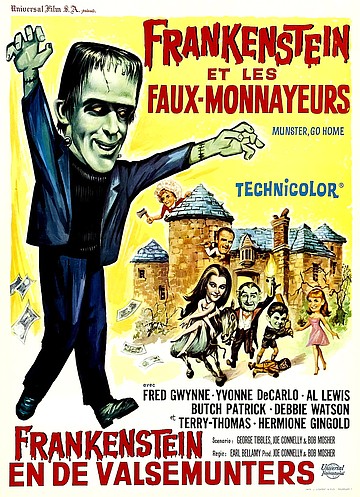
In the pilot episode, a deadpan Herman lumbered along like a soulless corpse. The series originally opened with a sad-eyed, innocuous Frankenstein’s monster emerging from behind the stairwell. Not until Lily plants a kiss does Herman turn into the giddy lug we all know and love. Imagine that pre-kiss characterization spread out for an entire episode. Instead of a declawed monster, producers Joe Connelly and Bob Mosher, the masterminds behind Leave It to Beaver, wisely turned Herman into a jejune goon, a childlike behemoth frightened by his own shadow. Gwynne later said of his monstrous alter ego, “Children believe Herman is real and, because of that, have fewer fears about imaginary monsters. It’s a very healthy situation.”
My second sojourn to Munster, Go Home! was held in the unlikeliest of screening facilities: the basement of my Hebrew School. It was the annual Magen David Adom food drive, and for the price of one canned good, students were treated to a scratchy, 16mm dye-transfer print projected in the same bema where Rabbi Jordani dovened mincha. The Rabbi wasn’t in attendance that afternoon, so the projection and hosting chores went to his aide-de-camp, Hyman Wolinitz. The congregation popped for the rental of a 16mm Bell and Howell Autoload, which sat on a folding table opposite a three-legged pull-down screen. Without bothering to check the leader, Hymie threaded up reel two (of three) and started the show.
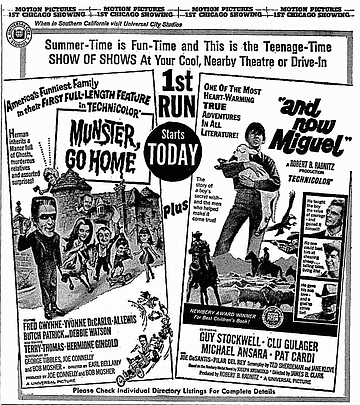
The “boos!” of little Jews began bouncing across the sanctuary. Seeing as it was an Autoload, no one could figure out how to unthread the projector and start the picture from the beginning. From over his shoulder, a visibly frustrated Wolinitz joked, “Uh, oh! Looks like one of the Munsters got out and tangled the film!” You may think me dumb, Hymie, just don’t talk me dumb. For the first time in my life I wanted to kill a projectionist. The crowd became surly, but the dyslexic presentation continued, the problem never rectified. What was I going to do, ask for a refund on my can of Green Giant Niblets?
The first two screenings did little for me. Perhaps it was my lifelong aversion to British comedies that kept me at bay. Who wants to watch The Munsters run through a de-humorizer? As a child, it never once dawned on me that the British supporting cast was already residing in America, and the entire production was shot on the studio backlot with 100 Universal City Plaza substituting for 10 Downing Street.
The dark, Technicolor cinematography is dazzling. With all due respect, there is no way that Benjamin Kline, a former cameraman for Edgar G. Ulmer (Detour) and The 3 Stooges (Grips, Grunts and Groans), could have achieved this effect by himself. Kline did shoot the My Fair Munster pilot in color, but a quick comparison indicates he must have put in a call to Universal’s in-house “Prince of Darkness,” Russell Metty (Written on the Wind, Touch of Evil), for the lighting bears more than a passing similarity to the crack cinematographer’s embossed hues.
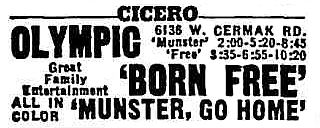
Short of being invited over to Scorsese’s screening room to see his mint 35mm dye transfer print, the closest you mortals will ever come to experiencing imbibition ecstasy can be found on The Munsters: America’s First Family of Fright. All of the trailers and TV spots were transferred from original Technicolor prints.
With the exception of a few minor alterations, the feature is basically a beefed up movie-of-the-week version of the show. Gone are the walk-on picture credits. The title design is the same, only now the Technicolor lettering drips blood red. While Jack Marshall’s familiar incidental music plays throughout, we never get to hear a full-blown rendition of the beloved theme song, not even under the closing credits. And it took a few minutes before I was able to pinpoint another essential ingredient that the film lacked — without the benefit of a laugh track, I had no idea how to react.
There is also the ceremonial changing of the Marilyns. Marilyn #1 was played by 25-year-old Beverly Owen. Ms. Owen was living every girl’s dream: she was young, beautiful, and signed to a seven-year studio contract. But she was also in love with a boy back East. When first she traveled from New York to Los Angeles to film the pilot, Owen didn’t think the series would take off. The lovesick, contractually bound starlet lasted 13 episodes before Fred and Al went to bat for her.
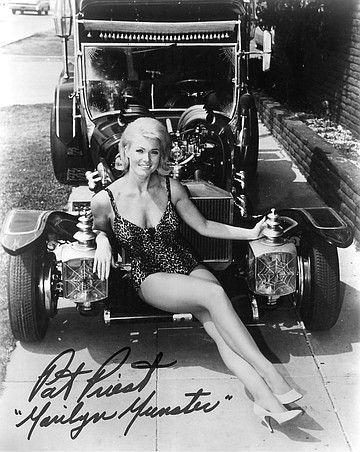
Beverly Owen’s marriage to Jon Stone lasted ten years, and we’re still talking about The Munsters to this day. Universal hired Pat Priest to fill in as Marilyn #2. The 30-year-old actress, far too old to convincingly play a teenage niece, got the gig because she fit the costumes. Debbie Watson, who had attracted a minor teen cult for her starring roles on the series Karen and Tammy, was drafted to play Marilyn #3 in the feature. She’s cute, perky, and closer in age to the character, but Marilyn was never given this much time on the show. Her love scenes with Robert Pine are instant air brakes.
Being a lifelong connoisseur of accelerated motion, there were enough sped-up reaction shots to hold my attention. Borrowing from the episode Grandpa’s Call of the Wild, everybody’s favorite 600-year-old Jewish blood-sucker turns himself a wolf that doubles as Lily’s fur wrap, while Herman dons a butch Wild One get-up to participate in a road race.
On the American side of the supporting cast we have Cliff Norton as the drunken running gag, Jack “Howard Sprague” Dodson as an under-cranked shipmate, and veteran character actor John Carradine picking up a paycheck and a hot bowl of soup. The English players are even less impressive: Terry-Thomas, Hermione Gingold, Richard Dawson, and insufferable Brit-for-hire Ben Wright will leave you begging for fade-outs. The shtick that worked on the TV show is still funny on the big screen, and any fan of the series has no doubt already committed it to memory. The Good Times video pressing that I screened was of more than acceptable quality. Originally intended as a TV movie, the film was shot full frame and is presented that way on the DVD.
Let’s close on a debate topic that rages to this day. You’re stranded on a tropic isle and only allowed one sitcom. Would it be The Munsters or The Addams Family?


My first eyeballing of Munster, Go Home! came, as it did to many Mockingbird Heights mavens of a certain vintage, on the bottom half of a double-bill. The film had not performed as well as expected, so a worried Universal Studios immediately reissued it in most parts of the country alongside the Don Knotts dud, The Ghost and Mr. Chicken, as part of a TV-theme combo.

Chicagoans, wishing they had something half as diverting as Mr. Chicken to justify their time spent waiting for Herman and the gang to appear, were asked to endure the long-forgotten family film, ...And Now Miguel, as an appetizer. Little Scooter, in Houston visiting Aunt Tubby (don’t ask!) and Uncle Jerry the week Munster, Go Home! premiered, returned home just in time for Grandpa Bill Marks to escort my cousins and me to the Olympic Theatre in Cicero, IL, where it played alongside the initiatory animal-rights drama, Born Free.
Other than seeing the gang in color for the first time, the strongest memory of my maiden viewing came on the bus ride home when out of the blue Pa, taken by the other film’s catchy theme, started warbling, “Born free, my father’s a doctor.” Pa was a frequent source of embarrassment, but we all loved him dearly.
This was not the first time “TV’s first family of fright” was committed to color stock. (Neither Universal nor CBS would pay the extra $10,000 per episode needed for color, so the show was subsequently filmed in black and white.) In 1964, Universal presented CBS with a 16-minute color demo reel in response to what they saw as the nation’s growing monster mania. A decade earlier the studio had sold its film library to television, and their classic creatures from the 1930s saw a resurgence in popularity. Suddenly monsters became fun and television smelled potential sitcom material. Ray Walston’s “Uncle Martin” was the first out-of-this-world jester to hit the airwaves, and My Favorite Martian became a surprise hit of the 1963 season.

You’ve heard the old saw about there never being enough quality roles for women in television? It couldn’t have been further from the truth in 1964 with a fall roster that saw no less than four supernatural sitcoms, all featuring juicy female leads. There was bewitching Elizabeth Montgomery as Samantha in Bewitched, Julie Newmar as a sexy robot cast opposite a hopelessly sexist Bob Cummings in My Living Doll, and a pair of ghoulish homemakers, Carolyn Jones in The Addams Family and Yvonne De Carlo in The Munsters.
The presentation of The Munsters that Universal put together for the CBS brass was shot on existing sets and used discarded music from a Doris Day picture as its theme. Fred Gwynne, Al Lewis, and Beverly Owen all made the cut, but the honchos insisted on recasting the role of Herman’s wife, Phoebe, played by Joan Marshall. They felt Ms. Marshall bore too close a resemblance to Morticia Addams. When news arrived that she was being replaced by backsliding movie star, Yvonne DeCarlo, both Gwynne’s and Lewis’s insecurity began to show. Would a seasoned movie star pack a lot of ego or, even worse, outshine the boys? Ms. DeCarlo was perfect in the role of Lily, and the actors later admitted they were wrong in their initial assumptions.
Popular child-actor Billy Mumy (Sammy, the Way-Out Seal, Lost in Space) was the original choice for Eddie Munster, but his parents wouldn’t agree to the extensive makeup it would take for their son to become a little wolfboy. Next up, Happy Derman, a monstrous little tyke whose one-note interpretation of Eddie Munster didn’t bode well. Derman’s sole shot at Munsterdom is preserved on the two DVD set

The Munsters: America’s First Family of Fright, a must for all collections. Happy looks a little like Larry Talbot after the third transformation dissolve. He walks hunched over, bares his Westmore fangs, and speaks in grunts and growls. Butch Patrick, the boy who would be Eddie, remembered his predecessor: “Happy Derman wasn’t very happy. He was the meanest little kid I’d ever seen.” Derman was a thoroughly off-putting little creature and, with all due respect to Butch, one I would have gladly spent two seasons watching.
Conceptually, The Munsters is little more than The Donna Reed Show, a typical sixties sitcom about a wholesome suburban family, played in greenface. And damn if the series doesn’t stand the test of time, due in large part to the perfect teaming of Gwynne and Lewis. The two had previously worked together on the NBC sitcom Car 54, Where Are You?, and their pairing as a Yiddish Grandpa Dracula and his goyish-kop seven-foot, olive-skinned son-in-law redefined genius.

In the pilot episode, a deadpan Herman lumbered along like a soulless corpse. The series originally opened with a sad-eyed, innocuous Frankenstein’s monster emerging from behind the stairwell. Not until Lily plants a kiss does Herman turn into the giddy lug we all know and love. Imagine that pre-kiss characterization spread out for an entire episode. Instead of a declawed monster, producers Joe Connelly and Bob Mosher, the masterminds behind Leave It to Beaver, wisely turned Herman into a jejune goon, a childlike behemoth frightened by his own shadow. Gwynne later said of his monstrous alter ego, “Children believe Herman is real and, because of that, have fewer fears about imaginary monsters. It’s a very healthy situation.”
My second sojourn to Munster, Go Home! was held in the unlikeliest of screening facilities: the basement of my Hebrew School. It was the annual Magen David Adom food drive, and for the price of one canned good, students were treated to a scratchy, 16mm dye-transfer print projected in the same bema where Rabbi Jordani dovened mincha. The Rabbi wasn’t in attendance that afternoon, so the projection and hosting chores went to his aide-de-camp, Hyman Wolinitz. The congregation popped for the rental of a 16mm Bell and Howell Autoload, which sat on a folding table opposite a three-legged pull-down screen. Without bothering to check the leader, Hymie threaded up reel two (of three) and started the show.

The “boos!” of little Jews began bouncing across the sanctuary. Seeing as it was an Autoload, no one could figure out how to unthread the projector and start the picture from the beginning. From over his shoulder, a visibly frustrated Wolinitz joked, “Uh, oh! Looks like one of the Munsters got out and tangled the film!” You may think me dumb, Hymie, just don’t talk me dumb. For the first time in my life I wanted to kill a projectionist. The crowd became surly, but the dyslexic presentation continued, the problem never rectified. What was I going to do, ask for a refund on my can of Green Giant Niblets?
The first two screenings did little for me. Perhaps it was my lifelong aversion to British comedies that kept me at bay. Who wants to watch The Munsters run through a de-humorizer? As a child, it never once dawned on me that the British supporting cast was already residing in America, and the entire production was shot on the studio backlot with 100 Universal City Plaza substituting for 10 Downing Street.
The dark, Technicolor cinematography is dazzling. With all due respect, there is no way that Benjamin Kline, a former cameraman for Edgar G. Ulmer (Detour) and The 3 Stooges (Grips, Grunts and Groans), could have achieved this effect by himself. Kline did shoot the My Fair Munster pilot in color, but a quick comparison indicates he must have put in a call to Universal’s in-house “Prince of Darkness,” Russell Metty (Written on the Wind, Touch of Evil), for the lighting bears more than a passing similarity to the crack cinematographer’s embossed hues.

Short of being invited over to Scorsese’s screening room to see his mint 35mm dye transfer print, the closest you mortals will ever come to experiencing imbibition ecstasy can be found on The Munsters: America’s First Family of Fright. All of the trailers and TV spots were transferred from original Technicolor prints.
With the exception of a few minor alterations, the feature is basically a beefed up movie-of-the-week version of the show. Gone are the walk-on picture credits. The title design is the same, only now the Technicolor lettering drips blood red. While Jack Marshall’s familiar incidental music plays throughout, we never get to hear a full-blown rendition of the beloved theme song, not even under the closing credits. And it took a few minutes before I was able to pinpoint another essential ingredient that the film lacked — without the benefit of a laugh track, I had no idea how to react.
There is also the ceremonial changing of the Marilyns. Marilyn #1 was played by 25-year-old Beverly Owen. Ms. Owen was living every girl’s dream: she was young, beautiful, and signed to a seven-year studio contract. But she was also in love with a boy back East. When first she traveled from New York to Los Angeles to film the pilot, Owen didn’t think the series would take off. The lovesick, contractually bound starlet lasted 13 episodes before Fred and Al went to bat for her.

Beverly Owen’s marriage to Jon Stone lasted ten years, and we’re still talking about The Munsters to this day. Universal hired Pat Priest to fill in as Marilyn #2. The 30-year-old actress, far too old to convincingly play a teenage niece, got the gig because she fit the costumes. Debbie Watson, who had attracted a minor teen cult for her starring roles on the series Karen and Tammy, was drafted to play Marilyn #3 in the feature. She’s cute, perky, and closer in age to the character, but Marilyn was never given this much time on the show. Her love scenes with Robert Pine are instant air brakes.
Being a lifelong connoisseur of accelerated motion, there were enough sped-up reaction shots to hold my attention. Borrowing from the episode Grandpa’s Call of the Wild, everybody’s favorite 600-year-old Jewish blood-sucker turns himself a wolf that doubles as Lily’s fur wrap, while Herman dons a butch Wild One get-up to participate in a road race.
On the American side of the supporting cast we have Cliff Norton as the drunken running gag, Jack “Howard Sprague” Dodson as an under-cranked shipmate, and veteran character actor John Carradine picking up a paycheck and a hot bowl of soup. The English players are even less impressive: Terry-Thomas, Hermione Gingold, Richard Dawson, and insufferable Brit-for-hire Ben Wright will leave you begging for fade-outs. The shtick that worked on the TV show is still funny on the big screen, and any fan of the series has no doubt already committed it to memory. The Good Times video pressing that I screened was of more than acceptable quality. Originally intended as a TV movie, the film was shot full frame and is presented that way on the DVD.
Let’s close on a debate topic that rages to this day. You’re stranded on a tropic isle and only allowed one sitcom. Would it be The Munsters or The Addams Family?
Comments